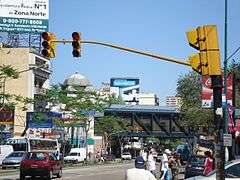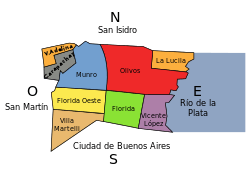Vicente López Partido
| Vicente López Partido de Vicente López | ||
|---|---|---|
| Department | ||
| ||
 location of Vicente López Partido in Greater Buenos Aires | ||
| Country | Argentina | |
| Established | December 21, 1905 | |
| Founded by | provincial law 2959 | |
| Seat | Olivos | |
| Government | ||
| • Mayor | Jorge Macri, PRO | |
| Area | ||
| • Total | 34 km2 (13 sq mi) | |
| Population | ||
| • Total | 270,929[1] | |
| Demonym(s) | vicentelopense | |
| Postal Code | B1636 | |
| IFAM | BUE131 | |
| Area Code | 011 | |
| Coordinates | 34°31′S 58°29′W / 34.517°S 58.483°W | |
| Patron saint | Jesús en el Huerto de los Olivos | |
| Website | http://www.mvl.gov.ar | |
Vicente López is a partido located in the north of Greater Buenos Aires in Buenos Aires Province, Argentina. The capital is Olivos. According to the 2001 national census, the partido has 269,420 residents. Vicente López is located 20 km from the city of Buenos Aires and 80 km from La Plata.
Its 33 km²[2] makes Vicente López the smallest partido of Buenos Aires Province.

Toponymy

The partido's name honors Vicente López y Planes, an Argentine writer and politician, the writer of the lyrics of the Argentine National Anthem, governor of Buenos Aires province (after the fall of Juan Manuel de Rosas) and then President of Argentina succeeding Bernardino Rivadavia.
López y Planes also composed El Triunfo Argentino, an ode to the resistance during the English invasion of Buenos Aires. At the beginning it was thought to call it "Olivos", the name of the most important district of Vicente López.
Location
The partido is bordered by the city of Buenos Aires to the South, General San Martín Partido to the West, San Isidro Partido at the North and Río de la Plata to the East.
Districts

- Carapachay
- Florida Este
- Florida Oeste
- La Lucila
- Munro
- Olivos
- Vicente López
- Villa Adelina
- Villa Martelli
In 1998, the municipality of Vicente López was named by the United Nations as the best in Latin America and the Caribbean.
Demography
Vicente López is the 8th most populated Partido of Greater Buenos Aires. Most of the inhabitants are descendants of Italian and Spanish immigrants. There are also descendants of German, Polish, Ukrainian, Armenian and Croatian amongst other nationalities.[3]
The partido has 280,929 inhabitants according to the 2010 Census.
References
External links
- Municipalidad de Vicente López
- Portal de Vicente López
- InfoBAN Vicente López
- Municipalidad de Vicente López at Google Cultural Institute

